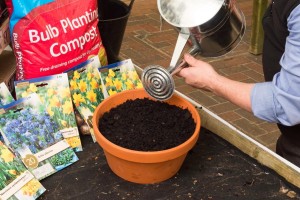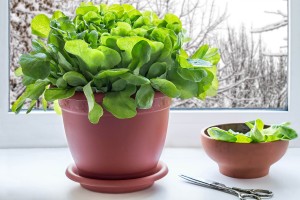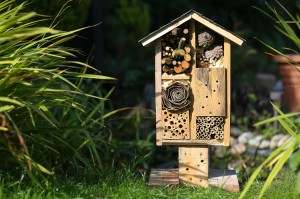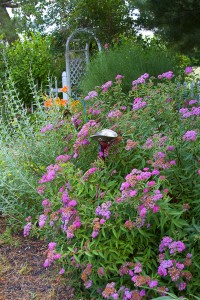|
Archive for the 'General Gardening' Category
Thursday, May 2nd, 2019
Admiral Nurse, Dave’s, advice for gardening with dementia
Dave Bell works on Dementia UK’s Admiral Nurse Dementia Helpline which is staffed entirely by specialist dementia nurses
Maintaining physical activity, cognitive function and social interaction, all helps someone who has dementia to remain stimulated, feel valued and helpful.
Being involved in gardening can really contribute to a person’s wellbeing. Gardening is on-going and ever-changing; anyone who has a garden will recognise that there is always something to do! Even if you have no garden, and have only limited space (perhaps for a few pots on windowsills) this is an activity that can give great pleasure. It can distract, engage, add to routines and be a focus for physical activity.
Gardening can provide a fantastic opportunity for stimulation of all the senses. There are the sensations of touch – soil, flowers, bark (but mind the thorns!), and perhaps the feel of a gentle wind, of sun or rain. There is visual stimulation – an amazing range of colour and shapes, sunlight, as well as the wildlife a garden can offer. There are the smells of flowers and vegetables, of herbs or of a freshly mown lawn. And there are the sounds – birdsong, insects, and rustle of wind in trees; and of course, there is taste – eating fruit, vegetables, and even edible flowers such as nasturtiums or marigolds.
It may be that someone’s memory difficulties and cognitive disability can get in the way of a whole sense of what is happening in the garden However, much activity for someone who has dementia is in the ‘here and now’, and the enjoyment of sharing a current task. This can be so rewarding in a garden, where the calmness of the surroundings can also lead to developing and sustaining relationships, not only through doing things together but also through the talk that always takes place.
There are many physical benefits – including dexterity skills and broader exercise through potting, planting, digging, sweeping, weeding and pruning – which can lead to reduced agitation and improved sleep.
There are cognitive benefits too – in terms of getting the person to help plan the activities, and perhaps to choose seeds and consider how flowers and vegetables are organised in the garden.
There are also huge benefits socially. For example, a caller on the Admiral Nurse Dementia Helpline said recently that she and her mother had never had so many conversations with others on their street as they did when they cut her hedge for an hour last summer, with Mum sitting on a chair, directing, while the daughter did the hard work!
Gardening activities for someone with dementia
There are many gardening activities which could involve the person living with dementia, whatever their disabilities. If they are physically able, they may be able to be prompted to do the tasks themselves. Otherwise, helping, or even just watching and feeling involved can be enough.
Tasks are there to do all year round, both indoors and outdoors.
- Planning – This can involve formal planning of how to lay out the garden. It can include a visit to a local garden centre together – a pleasant experience in itself. These are usually safe and easy to navigate places, often with disabled loos and usually with a café attached!
- Preparing –If the person is able, they can help (or be helped) with preparing beds for sowing, by weeding, removing stones and spreading compost. Getting pots and trays cleaned and ready for sowing is another satisfying task that can be done together.
- Planting – Planting seeds can be done together, both indoors and out. Together you can buy seeds and sow them in pots or trays in a greenhouse or on a windowsill. If planting directly into the ground, you can work together to make the rows and sow the seeds, and both be involved in watering and tending as shoots appear.
- Potting and planting out – As seedlings get strong enough, another shared task is repotting or planting out – careful dexterity may be needed, and lots of kneeling! Raised beds can make life a lot easier if you have the space. Again, the garden centre can be a good place to visit, to buy flowers and vegetables already in pots and ready to plant out at home.
- Maintenance – This is the on-going, and sometimes most challenging part of gardening! Weeding and watering, as well as fighting off bugs and pests can be a constant battle, but can be hugely satisfying. There are also tasks to do in dead-heading flowers like roses, or in thinning out of plants.
- Picking/harvesting – This is the fun part of gardening. Picking flowers together can be a wonderful experience. The joy of picking fruit and vegetables such as tomatoes, strawberries, beans, peas etc. can involve all the senses, and can be a great opportunity for reminiscing and sharing experiences.
- Using the produce –This can involve flower arranging or even giving bunches of freshly picked flowers to friends and family which can enhance a person’s sense of self-esteem. Using vegetables in cooking together is a multi-sensory activity, and having a herb garden, or even a range of herbs in pots in the kitchen, can bring back memories and encourage conversations. And it can be a very satisfying few hours spent making jam.
Case study
Anne, a lady of 92, had kept a garden at home, but sadly had to move to a nursing home as her mobility and cognition reduced. At first she became quite distressed and often called out, as despite the efforts of staff to keep her engaged and stimulated, she spent so many hours alone in the chair next to her bed with just the TV for company.
Fortunately the home found out from her family about her love of her garden and, when a room became available facing onto the garden, Anne was able to move there, where she had a French window that opened onto a patio and a flower bed beyond. Her daughter set up a variety of pots in her view.
Even though she was unable to do much of this herself, Anne could give directions to her daughters, smell and taste the flowers and produce, and, with a bird table set up in her view, could watch the constant stream of birds and even squirrels, come and feed. Her agitation and feelings of isolation were almost immediately reduced, and the new found pleasures enhanced her relationships with staff and other residents.
Filed: General Gardening
Monday, October 29th, 2018
More than half of Brits abandon their garden every winter
-
40% of homeowners fail to prepare their garden for the harsh British winters
-
52% don’t manage the upkeep of their outdoor space throughout the colder months
-
Experts offer their tips on how to look after your garden in winter with minimal effort
Who doesn’t love spending time in their garden when the summer sun is shining? But for many, the temptation to make the most of your garden furniture and the motivation to spend time preening your plants to perfection dramatically drops as the colder weather rolls in.
Outdoor building manufacturer, Tiger Sheds, surveyed the nation to unveil their garden habits, revealing that a massive two in five (40%) of Brits don’t take precautions to prepare their garden or garden buildings for the cooler weather.
What’s more, 52% completely abandon their gardens and fail to do any gardening throughout winter. Almost one in ten (9%) said that they don’t care for their garden in winter because they think that their plants will die regardless, and 8% said they would just replace anything that that is damaged by the winter weather – but at what cost?
As a nation we are keen to retreat indoors as soon as the chilly weather hits, with only 4% of Brits saying winter is the season they spend the most time caring for their garden. It seems the frosty weather is quick to discourage even the most avid gardeners from pottering around their outdoor space, with the cold temperature coming out as the number one reason to avoid gardening in the winter (67%).
The top four reasons people don’t garden in the winter are:
1) It’s too cold to be outside gardening (67%)
2) The flowers and leaves don’t come through until spring so there is little payoff (31%)
3) Not spending enough time outdoors in the winter for it to be worth it (25%)
4) Slippery surfaces (20%)
Abandoning our gardens while we spend less time in them may seem inevitable, however, experts from Tiger Sheds offer four top tips for homeowners to ensure their garden and garden buildings survive the frosty weather and all the money and time spent perfecting green spaces in the summer months does not go to waste.
Protect your garden buildings
Make sure to weatherproof your building before the cold weather hits to reduce the risk of rot in the damp environment. You can also help protect your outdoor building with a simple lick of paint! As well as giving your garden a new lease of life, applying a fresh coat of paint gives your building some extra protection for the winter.
Another tip is to check that the windows and doors of your garden building are well-sealed to ensure that water can’t get in and cause further unwanted damage.
Don’t abandon your plants
There’s still life in them yet! Keeping your plants warm and dry is key for their survival. If you can, move plants indoors to keep them out of the cold and rain. If this isn’t possible, try to keep your plants near fences and other sheltered areas. To shield your plants from frost, use a protective cover overnight.
Grouping your potted plants together and/or wrapping them in bubble wrap will also help to keep them warm and prevent them from freezing or getting blown over in the bleak conditions. It’s also good to keep your plants in pots with drainage holes so excess moisture from heavy rainfall can drain out.
Store away garden furniture
Garden furniture can easily get damaged in the winter weather so it’s a good idea to store it away, ideally in a garden shed, where it can be sheltered from the snow and rain. Despite being designed to be outside, the wet weather makes furniture susceptible to damage so it’s good practice to pack it away before winter kicks in.
Don’t forget to maintain!
Maintenance matters – more than half of the nation (52%) tend to forget to look after their gardens during the colder seasons. Gardening in the winter doesn’t have to be strenuous but taking some time to look after your green space will make all the difference. One key tip is to keep trimming away problematic branches to reduce the risk of damage that could be caused in harsher weather.
Although it may not be the first area you think of when it comes to looking after your garden, the winter can have harsh effects on your lawn, so it’s important to stay on top of maintenance. Make sure you clear up any dead leaves as these prevent the grass from getting sunlight and water. It’s also a good idea to fertilize your lawn to restore any nutrients lost as a result of the frosty weather.
Commenting on the findings, Jack Sutcliffe from Tiger Sheds said, “Understandably, it can be easy to ignore your garden in the winter, but it’s important to look after it throughout the colder months to ensure your green space bounces right back once spring comes along.
“These tips are easy to follow yet can go a long way in protecting your garden from the cold British winter and ensure all the time, effort and money spent taking care of your garden in spring/summer wasn’t in vain.”
For more information on how you can look after your garden and garden buildings in winter, visit: https://www.tigersheds.com/thehiphorticulturist/winter-garden-care/
Filed: General Gardening
Sunday, June 4th, 2017
ARE YOU THE UK’S BEST AMATEUR GARDENER?
One of Britain’s best loved value home and garden retailers, Wilko is looking for green fingered locals to enter the 2017 ‘Wilko Amateur Gardener Of The Year’ competition.
Research suggests the UK is a secret haven of garden enthusiasts – with 88%* of UK residents rating having a nice garden as important, according to a national survey.
Six lucky entrants from across the UK will be picked as category winners, shortlisted by an experienced garden judging panel, including Dominic Cole, President of The Gardens Trust and award-winning garden designer, Andrew Fisher Tomlin, before being selected by a public vote on the Wilko social media channels.
The categories to enter are:
v Best Allotment
v Best Garden Design
v Best Hanging Basket/ Container
v Best Junior Gardener
v Best Wildlife Garden
v Best Upcycled Garden
The competition is open until 30 June 2017 and the winners of each category will receive a £100 Wilko gift card and trophy. One of the six finalists will be crowned overall Wilko Amateur Gardener Of The Year 2017 and receive an additional £250 Wilko gift card.
To be considered, simply email an image of your garden to wilkogardener@wearebrazenpr.com including name, email address, telephone number and the category you wish to be considered for.
Full competition details and terms and conditions can be found at: www.wilko.com/show-by-departmet/garden/icat/wilkogarden
Finalists will be informed on 21 July 2017 if they have been shortlisted for the categories.
Lloyd Taylor, Head of Garden Category, from Wilko said:
“We know that UK residents are garden lovers and we want to celebrate those skilled amateur gardeners who might not otherwise be recognised for their talents. We’re spreading the word to encourage entries and look forward to seeing the work of garden enthusiasts from up and down the country.”
So if you think you have the expertise to be the next Wilko Amateur Gardener Of The Year 2017 – enter now.
Filed: General Gardening
Friday, March 10th, 2017
 Haskins reaches fundraising target to train puppy for Canine Partners Haskins reaches fundraising target to train puppy for Canine Partners
The team working at Haskins Garden Centre in Roundstone has exceeded its fundraising target to pay for charity Canine Partners to train a new puppy.
Staff raised £6,564.00 for the charity over a two year period through fundraising initiatives at the centre. Canine Partners relies on public donations to assist people with physical disabilities by partnering them with assistance dogs. It costs the charity £5,000.00 to purchase a puppy and pay for training, equipment, toys, vet bills, insurance and transport.
Mel Howick, customer services team leader said: “The whole team has thoroughly enjoyed raising funds for Canine Partners. We are all huge dog fans here and it was great that so many customers backed our fundraising efforts too.
“We’re so proud that we’ve smashed our target and we now need to come up with a name for the new puppy.”
Jane Grant, corporate and community engagement manager for Canine Partners, said: “We are extremely grateful to Haskins Roundstone’s staff and customers for raising so much money for Canine Partners through their Wishing Well Appeal.
“They have raised enough to name one of our puppies and sponsor it through its first year of training with one of our volunteer puppy parents.
“We receive no government funding, so we rely on the generosity of supporters like Haskins in order to raise the money we need to continue transforming the lives of disabled people through our amazing dogs.
“Canine partners are trained to help with a range of everyday tasks, including opening doors, picking up dropped items, undressing a person and even unloading a washing machine. These skills help our dogs change lives by boosting disabled people’s independence and confidence.”
Haskins Garden Centres are located at Ferndown in Dorset, West End in Southampton and Roundstone and Snowhill in West Sussex.
Filed: General Gardening
Friday, February 3rd, 2017
 Camellias for early colour Few hardy shrubs signal the end of winter better than camellias, the Horticultural Trades Association’s (HTA) ‘Plant of the Moment’ for February, providing some welcome colour through late winter and into early spring. Highly valued for their stunning floral displays and fresh, glossy, evergreen foliage and with dozens of varieties available, you’ll be spoilt for choice, so pick from camellias in shades of pink, red, white and cream. Their ultimate size, habit and rate of growth vary immensely too, so consider how much space the camellia will need as it grows. Whether you’d like something that stays small and compact or will grow into a bold shrub or even a flowering hedge or screen, the choice is yours. Like azaleas and rhododendrons, camellias are ericaceous plants, and this means they need to grow in an acid or lime-free soil to ensure they stay healthy. Alternatively, compact varieties of camellia grow well in large pots or half-barrels filled with ericaceous compost, available in garden centres. Top four popular camellias for pots or borders are: Camellias for early colour Few hardy shrubs signal the end of winter better than camellias, the Horticultural Trades Association’s (HTA) ‘Plant of the Moment’ for February, providing some welcome colour through late winter and into early spring. Highly valued for their stunning floral displays and fresh, glossy, evergreen foliage and with dozens of varieties available, you’ll be spoilt for choice, so pick from camellias in shades of pink, red, white and cream. Their ultimate size, habit and rate of growth vary immensely too, so consider how much space the camellia will need as it grows. Whether you’d like something that stays small and compact or will grow into a bold shrub or even a flowering hedge or screen, the choice is yours. Like azaleas and rhododendrons, camellias are ericaceous plants, and this means they need to grow in an acid or lime-free soil to ensure they stay healthy. Alternatively, compact varieties of camellia grow well in large pots or half-barrels filled with ericaceous compost, available in garden centres. Top four popular camellias for pots or borders are:
- ‘Donation’ – Semi-double rose-pink flowers. Upright habit. Strong growing.
- ‘Adolphe Audusson’ – Bright red flowers. Strong growing.
- ‘Debbie’ – Peony-form pink flower. Upright. Strong growing.
- ‘Lavinia Maggi’ – Large double white flowers with pink stripes. Medium vigour.
Top tip Early flowering camellias can be damaged by frost, so position plants in a sheltered part of your garden. Move pots to sheltered sites during bad weather. Cover bushes with sheets of fleece to protect buds and blooms on frosty nights, removing it once conditions warm-up in the morning. Planting combinations Choose a range of hardy shrubs, flowering perennials and bulbs to grow in combination with camellias, as well as a selection of ground covering plants that will spread out over the soil beneath bushes. Here are some popular choices:
- Azaleas
- Conifers, including yew
- Crocus
- Cyclamen
Visit www.the-hta.org.uk/plantofthemoment for more information and to download the media pack which features: plant information for each month including top plants, tips and companion plant ideas, high and low resolution photos, plus Point-of-Sale samples from Floramedia and Hortipak.
Filed: General Gardening
Thursday, November 24th, 2016
 Haskins Garden Centres creates a colourful spring planter Haskins Garden Centres creates a colourful spring planter
The team at Haskins Garden Centres has launched a spring bulb planter guide to add a burst of colour after the dullness of winter.
Alasdair Urquhart, plant advisor at Haskins Garden Centre in Ferndown, said: “By carefully choosing your bulbs, you can create a stunning display ready for the new year. We recommend using the lasagne bulb planting technique to ensure you get the most out of your spring planter.”
Here are some tips on how to create a colourful daffodil and scilla spring planter:
- Purchase the yellow dwarf daffodil ‘jetfire’ to contrast against the blue of ‘scilla siberica’.
- Choose a wide, shallow pot to complement the proportions of the dwarf daffodils and cover the drainage holes to prevent the soil from leaking out.
- Add a layer of bulb compost and arrange the daffodils first. Daffodils should be planted pointy end up. Bulb compost ensures the daffodil bulbs can be planted at the correct depth.
- Cover the daffodils with compost and plant a layer of scilla evenly across the pot, producing a layered lasagne effect.
- Cover the second layer with more compost. If the pot is deep enough, continue to add more layers of smaller bulbs. Water the pot to allow the soil to settle and every February, use a slow release or proprietary fertiliser to help bring the bulbs on. Remember to dead-head the flowers when necessary.
Haskins Garden Centres are located in Ferndown in Dorset, West End in Southampton and Roundstone and Snowhill in West Sussex. For more information visit www.haskins.co.uk
Filed: Flowers, General Gardening
Tuesday, July 19th, 2016
  Get the children interested in gardening this summer with top tips from Haskins Garden Centres Get the children interested in gardening this summer with top tips from Haskins Garden Centres
Haskins Garden Centres has some great ideas for those wanting to get their children interested in gardening this summer.
Just in time for the school holidays, Haskins has launched ‘Garden Gang’ to provide parents with free gardening projects and activities to keep outdoor busy bees entertained. There are a variety of quizzes, puzzles and games in the ‘Garden Gang’ section of Haskins’ child-friendly website.
Garden Gang activities include:
Making a bug home
Children will love attracting bugs and bees into the garden with a simple home, made out of bamboo sticks. Bumble bees, solitary bees and ladybirds particularly like crawling into holes.
Making a bird snack
Mix together seeds, nuts and crumbs with lard and place in a coconut shell, then into a freezer bag and freeze. The whole family can enjoy hanging this in the garden and watching the birds enjoy a homemade snack.
Growing lettuce on a window sill
Lettuces are easy to grow through to late autumn. Fill a seed tray with soil and loosely pat down. Sow lettuce seeds as directed on the packet and cover lightly with seed compost. Spray the tray lightly with water and cover with a lid or plastic bag, then place the tray on a warm window sill. The first shoot should appear within 1-3 weeks.
Alasdair Urquhart, plant advisor at Haskins in Ferndown, said: “Our Garden Gang projects are a great opportunity for getting outside into the fresh air and having family fun. The garden is a great classroom, providing somewhere safe and rewarding to learn how to make the space more wildlife-friendly.”
Haskins is located in Ferndown in Dorset, West End in Southampton and Roundstone and Snowhill in West Sussex. For more information, visit www.haskins.co.uk/garden-gang
Filed: Fun stuff, General Gardening
Thursday, June 9th, 2016
 Haskins Garden Centres has released its latest summer gardening trends including everything from vivid displays to relaxed gardens, and small trees to traditional roses. Haskins Garden Centres has released its latest summer gardening trends including everything from vivid displays to relaxed gardens, and small trees to traditional roses.
Alasdair Urquhart, plant advisor at Haskins Garden Centre in Ferndown, said: “This summer is shaping up to be exciting for gardeners. Bright flowers such as dahlias are back in fashion, as well as traditional rose bushes. To suit those with hectic lifestyles or smaller outdoor areas, low maintenance ideas are becoming more and more popular as well as compact plant varieties such as fruit trees.”
Haskins Garden Centres (www.haskins.co.uk) in Ferndown in Dorset, West End in Southampton and Roundstone and Snowhill in West Sussex have the following summer trending plants for sale:
- Dahlias from £7.99
- Echinacea from £8.99
- New Guineas, coastal geraniums and osteospermum £3.99 each, or for 4 for £15
- Echeveria from £4.99
- Sempervivum from £1.95
- Mizune, red veined sorrel £2.49
Succulents:
Plants such as echeveria or sempervivum are low cost and have strong architectural shapes which suit rustic or unusual bowls. These types of plants also require little care as they store water in their leaves, so are low maintenance for those with a busy schedule.
Vivid colours:
Vibrant and strong coloured flowers such as dahlia, echinacea and rudbeckia are springing up in more gardens this summer to give a powerful look. Impatiens New Guinea are fluorescent, even when growing in the shade, and are a great replacement for Busy Lizzies.
Roses:
The classic rose is featuring again in garden trends, especially fragrant, repeat flowering climbers and ramblers. Haskins Garden Centres is currently hosting a Rose Festival until Thursday July 28, to showcase the vast amount of colours, varieties and versatility of roses.
Compact plants:
Downsized, compact plant varieties are on the up as more and more of our gardens are getting smaller. Smaller varieties of trees, especially fruit trees on dwarfing root stocks and low growing shrubs are ideal for smaller gardens as they help keep the space in proportion.
Container gardening:
Edible plants and berries are continuing to grow in popularity as they can be easily planted in pots or baskets and can tolerate cold winters. Blueberries, and unusual salad leaves such as Japanese Mizune or Red-veined Sorrel also grow year after year.
Relaxed planting styles:
The naturalistic cottage garden is back on trend thanks to its low care requirement and the bright colours attract beneficial insects.
For more information please visit www.haskins.co.uk
Filed: General Gardening
Monday, April 27th, 2015
Stewart Garden to exhibit at Glee 2015
Stewart Garden, the gardening division of UK manufacturer, Stewart, is returning to Glee in 2015.
Coinciding with Stewart’s 70th Anniversary year, Glee 2015 will see the company launch several new products and display many of its most popular existing ranges.
Stewart Garden manufactures its products from quality plastic at its state of the art factory in Banbury. These include grow your own products, pots, watering equipment, propagators and garden accessories.
Andy Burns, managing director at Stewart, said: “Glee is one of the garden industry’s major events, so we’re delighted to be returning. As we celebrate our 70th anniversary, this year’s show allows us to show the strength and heritage of our brand.”
Now in its third year in Banbury, Stewart Garden has consolidated its position as the market leader in grow your own and contemporary lifestyle garden products. Not content to rest on its laurels, the business continues to invest in expanding its manufacturing capacity. As a result, Stewart Garden has built inventories to unprecedented levels as it looks to deliver excellent levels of availability and customer service for the coming season.
Lara Anderson, account manager at i2i Events, organiser of Glee, said: “It’s great to have Stewart Garden back at Glee. It’s a fantastic heritage brand that always attracts great audiences to the show. We’re excited to see what new products Stewart Garden will launch at Glee this year.”
Stewart Garden’s grow your own products, pots, watering equipment, propagators and garden accessories are available in over 1,600 outlets across the UK and Eire. These include DIY outlets such as Homebase and Wilkinsons and garden centres such as Dobbies and Klondyke/Strikes, Wyevale and over 600 independent garden centres.
Glee 2015 will host over 500 UK and international wholesale garden suppliers. The show takes place at the NEC, Birmingham from 14-16 September.
For more information, visit www.stewart-garden.co.uk.
Filed: General Gardening
Monday, April 21st, 2014
Listen to Gardeners Question time on the iplayer. – this episode was recorded in Eccles on the 7th April and brodcast on Easter Sunday. I was at the college for the recording. It was great fun!
They ask more questions than make it to the final cut. It was really good fun and I recommend you try and get to one if they come and record near you.
Check the GQT on location page to find out where they’ll be next! There was a small charge made by the college for going but it was only £3.50
When you go in you get given a piece of paper to fill in your question on. You hand this to one of the crew and then they decide which ones to ask. The people asking the questions were asked to go to the front row so the sound man could get to them easily.
The producer comes in first and tells you about the show and then disappears into the radio van outside. A sound engineer sits at his desk in the corner and the presenter has headphones on so he can hear the producer. The garden experts sit at a table and answer the questions. They don’t all answer every question. It was interesting seeing them scribble notes.
Gardeners Question Time is a fantastic institution that’s entertaining and educational as well as really interesting. Local gardeners asking questions about real problems, and there’s always some humour!
I will be going again and next time I might pluck up courage to ask a question!
Filed: General Gardening
|
|












